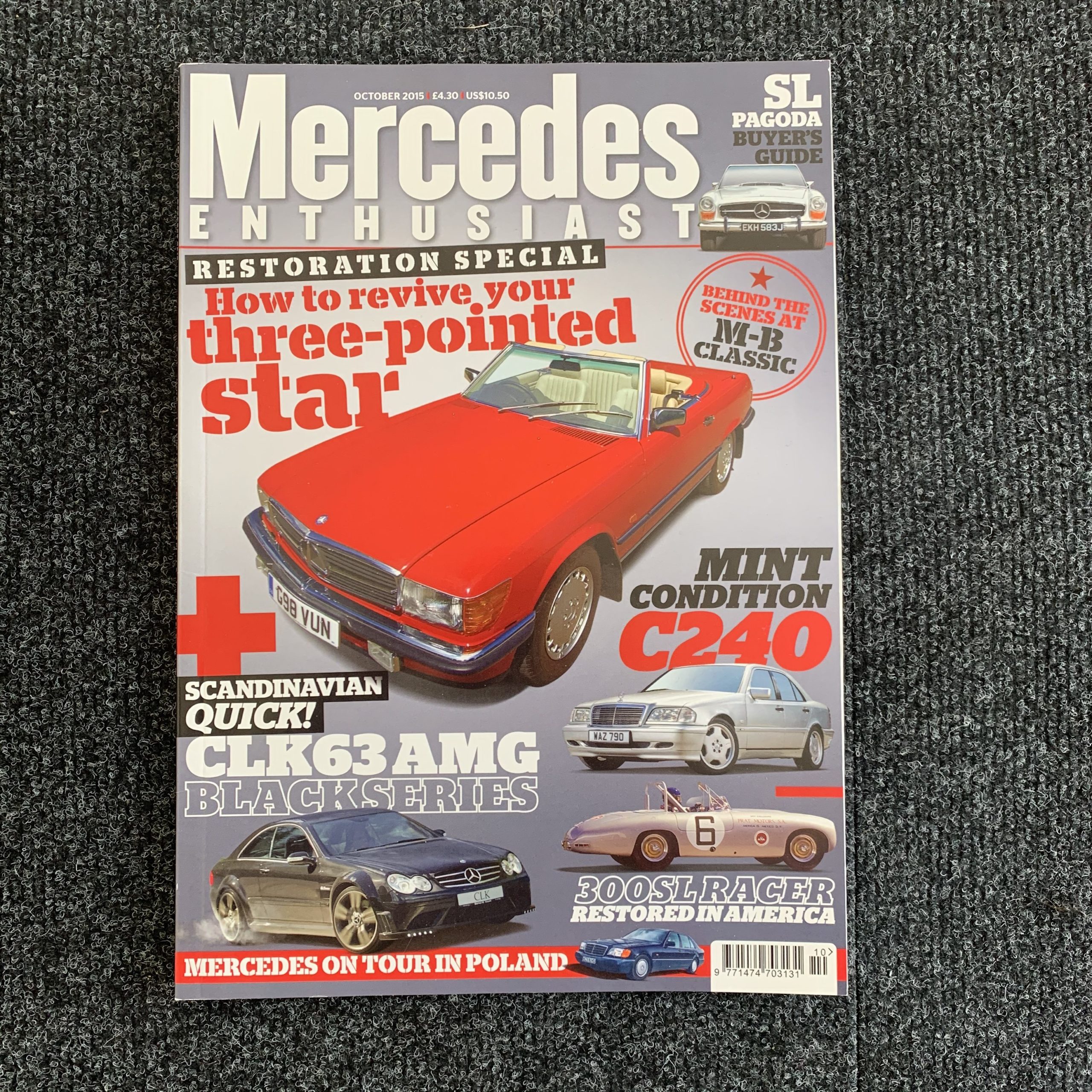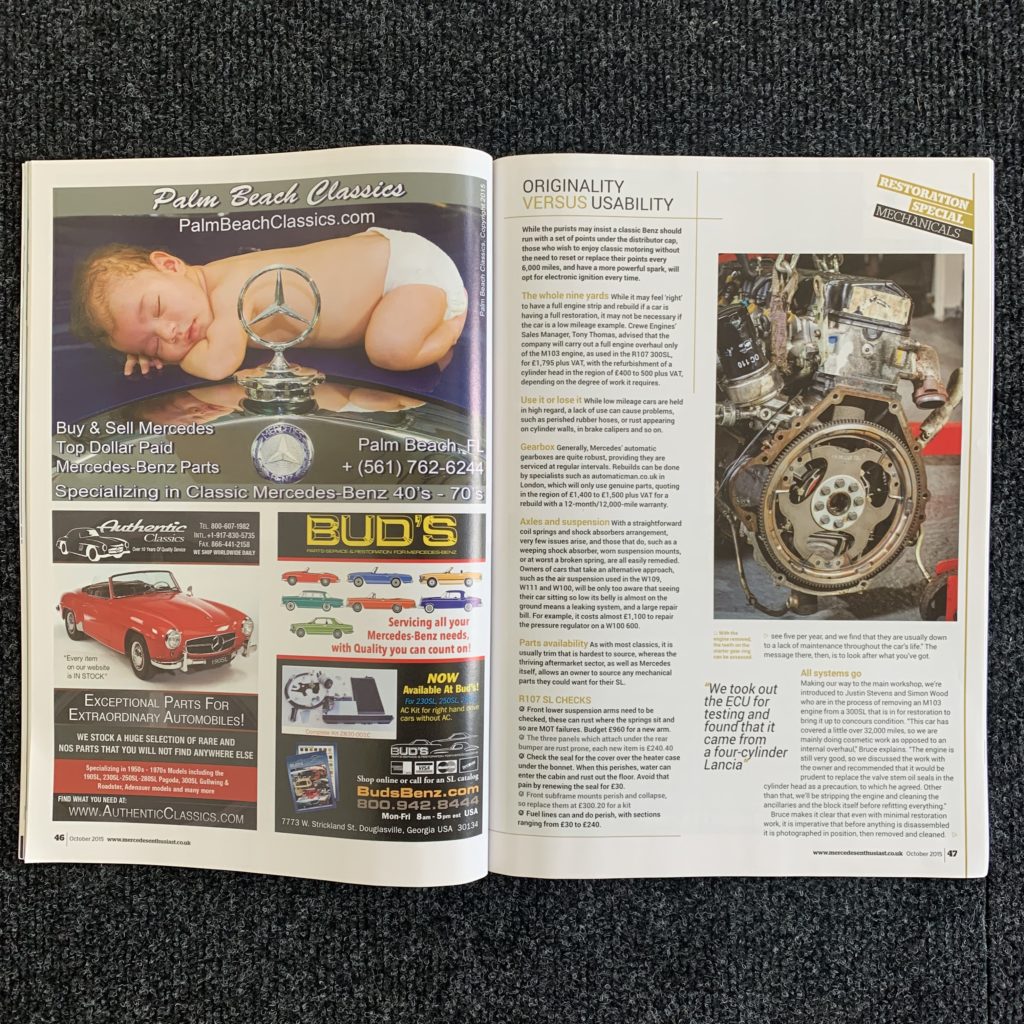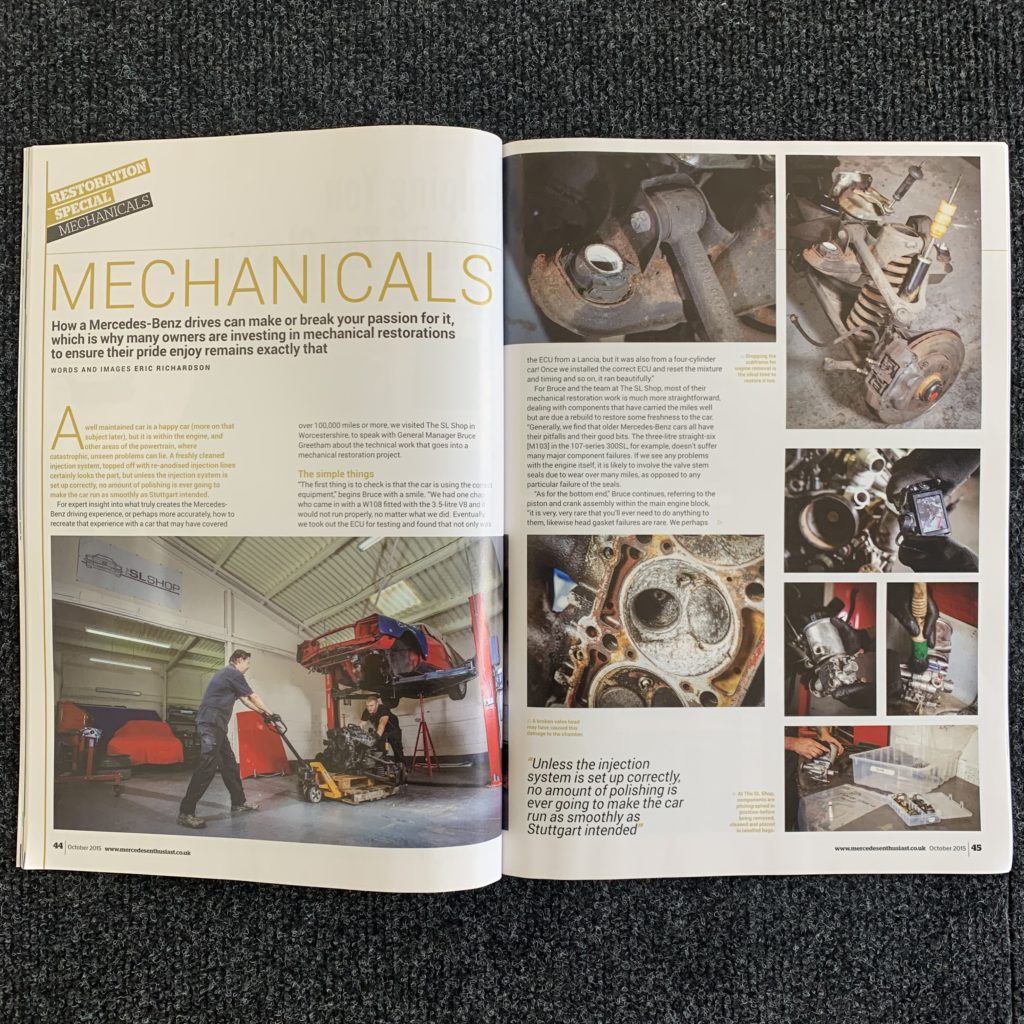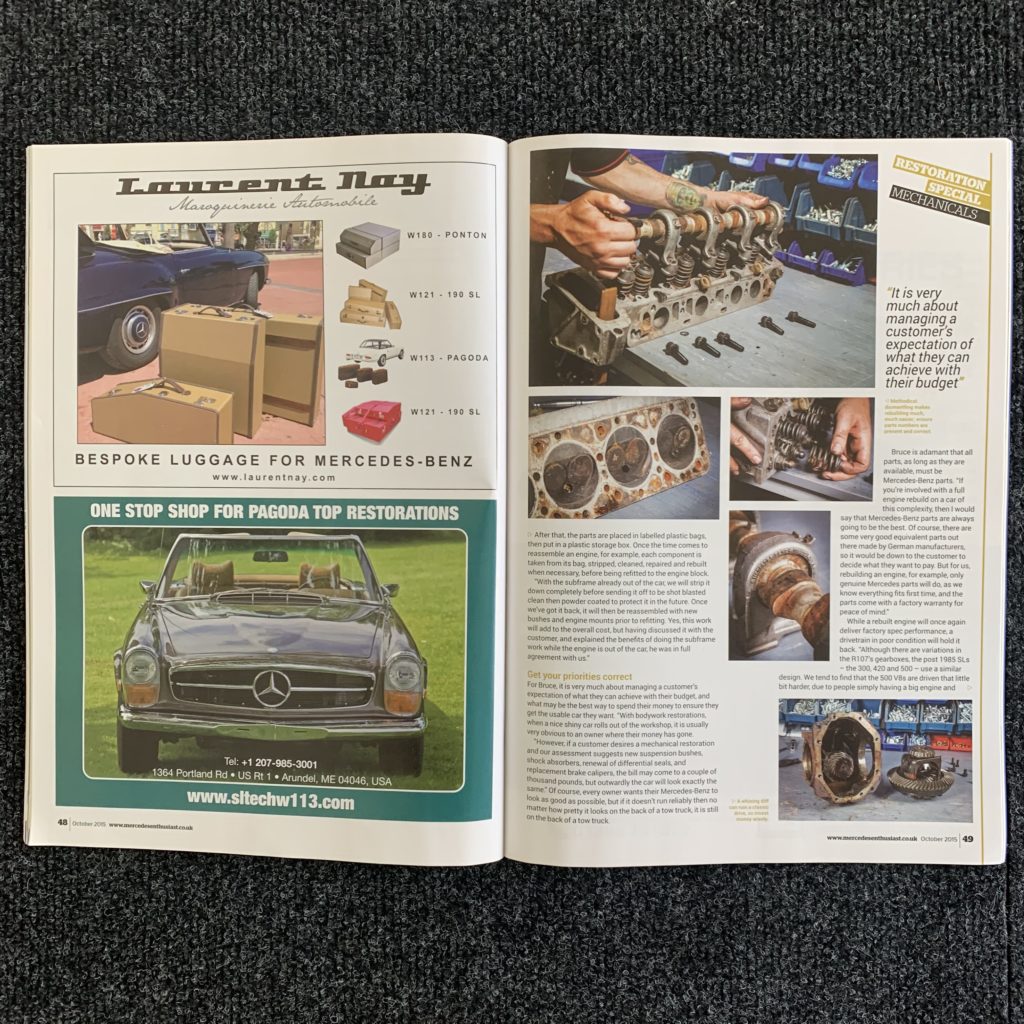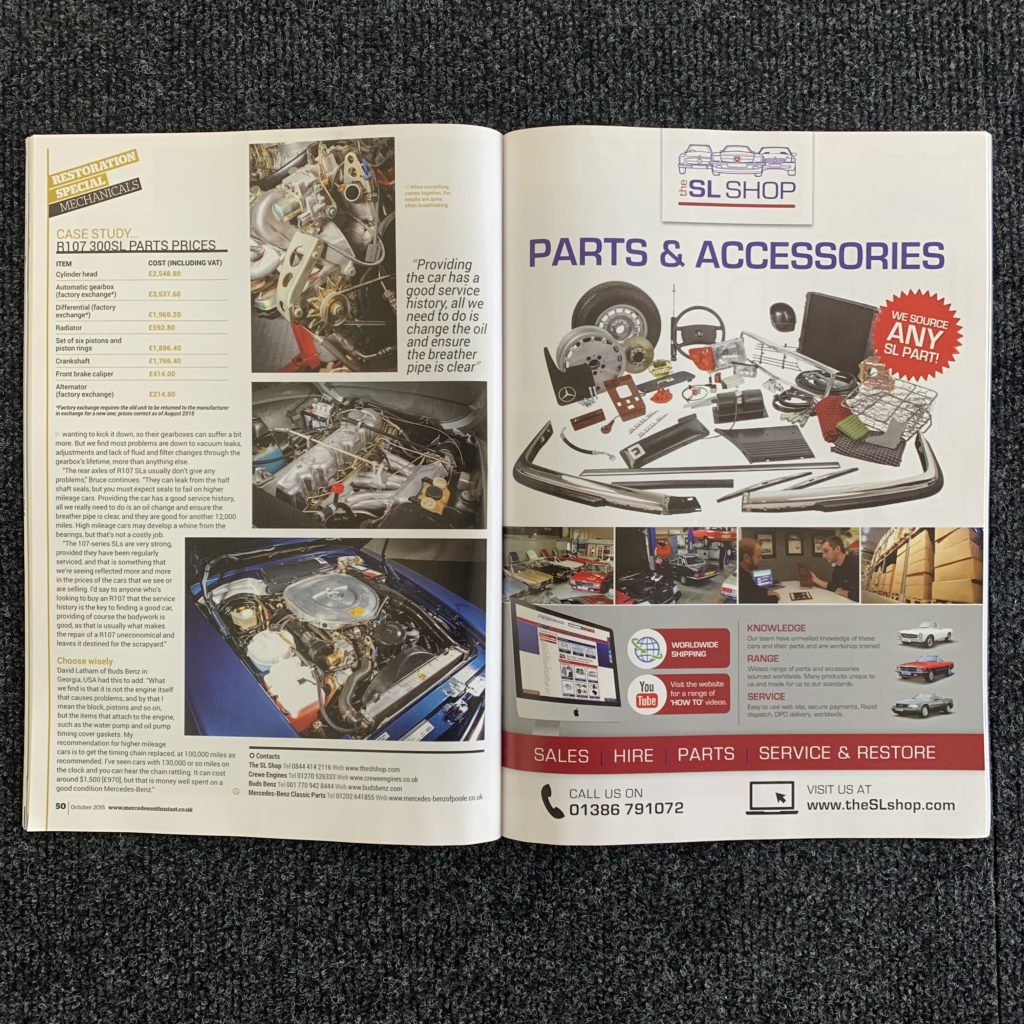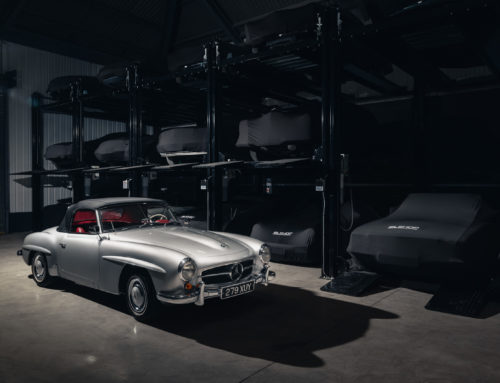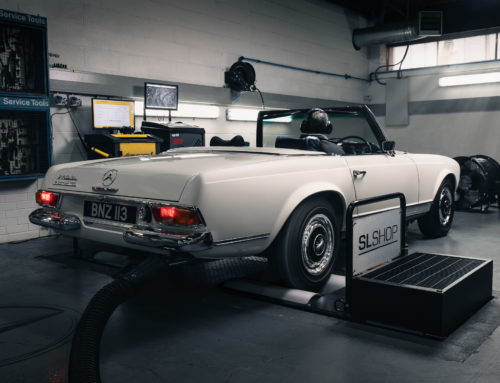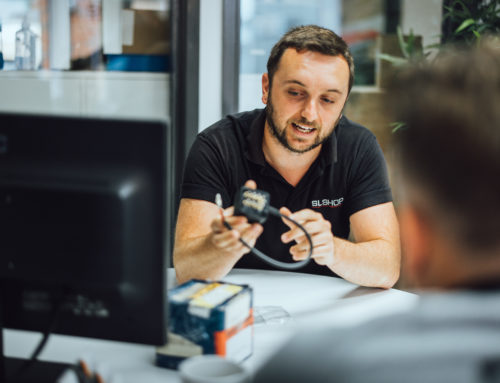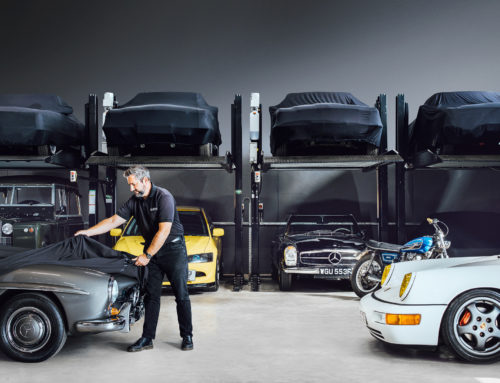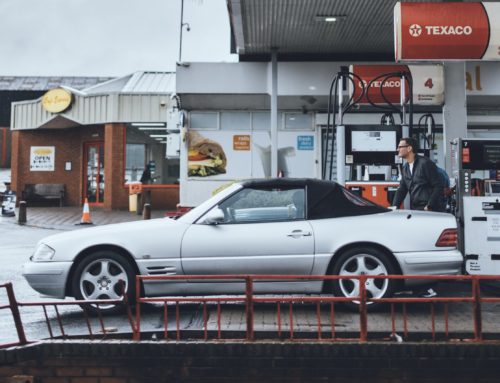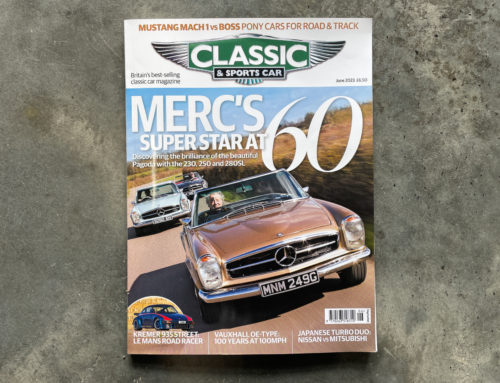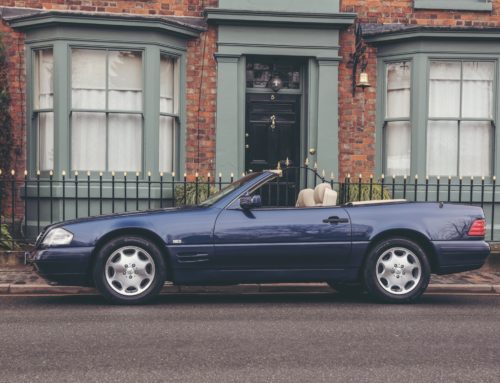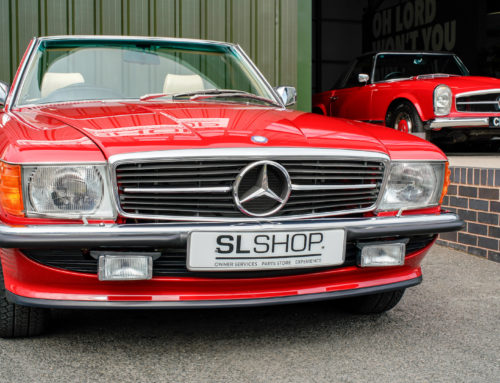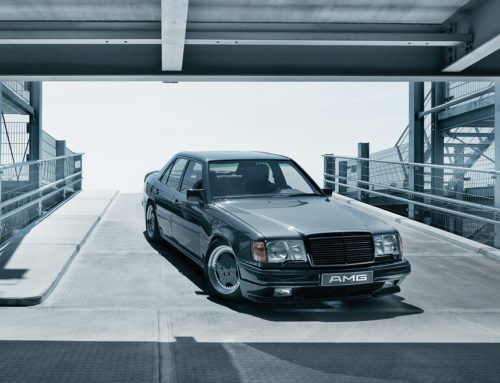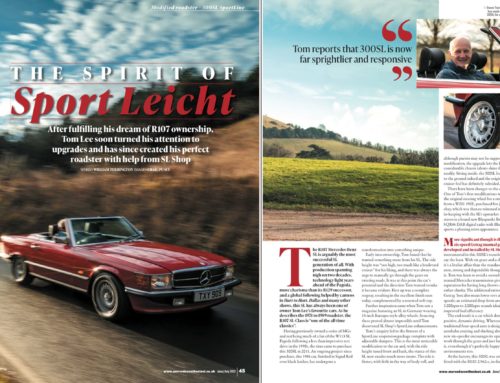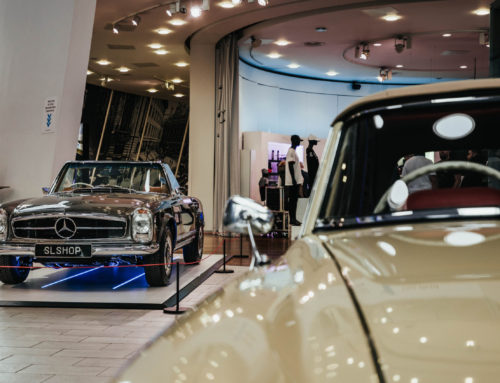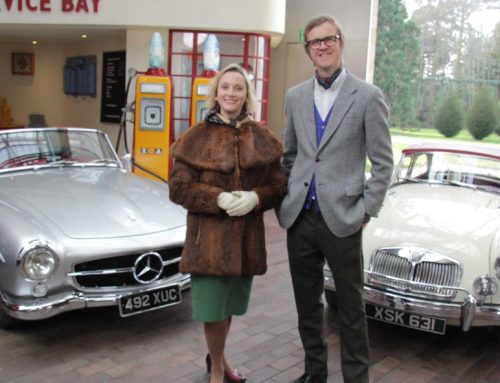Mechanicals
How a Mercedes-Benz drives can make or break your passion for it, which is why many owners are investing in mechanical restorations to ensure their pride and enjoy remains exactly that.
A well-maintained car is a happy car (more on that subject later), but it is within the engine, and other areas of the powertrain, where catastrophic, unseen problems can lie. A freshly cleaned injection system, topped off with re-anodised injection lines certainly looks the part, but unless the injection system is set up correctly, no amount of polishing is ever going to make the car run as smoothly as Stuttgart intended.
For expert insight into what truly creates the Mercedes-Benz driving experience, or perhaps more accurately, how to recreate that experience with a car that may have covered over 100,000 miles or more, we visited The SL Shop in Worcestershire, to speak with General Manager Bruce Greetham about the technical work that goes into a mechanical restoration project.
The simple things
“The first thing is to check that the car is using the correct equipment,” begins Bruce with a smile. “We had one chap who came in with a W108 fitted with the 3.5-litre V8 and it would not run properly, no matter what we did. Eventually, we took out the ECU for testing and found that not only was the ECU from a Lancia, but it was also from a four-cylinder car! Once we installed the correct ECU and reset the mixture and timing and so on, it ran beautifully.”
For Bruce and the team at the SL Shop, most of their mechanical restoration work is much more straightforward, dealing with components that have carried the miles well but are due a rebuild to restore some freshness to the car. “Generally, we find that older Mercedes-Benz cars all have their pitfalls and their good bits. The three-litre straight-six (M103) in the 107-series 300SL, for example, doesn’t suffer many major component failures. If we see any problems with the engine itself, it is likely to involve the valve stem seals due to wear over many miles, as opposed to any particular failure of the seals.
“As for the bottom end,” Bruce continues, referring to the piston and crank assembly with the main engine block, “it is very, very rare that you’ll ever need to do anything to them, likewise head gasket failures are rare.
We perhaps see five per year, and we find that they are usually down to a lack of maintenance throughout the car’s life.” The message there, then, is to look after what you’ve got.
All systems go
Making our way to the main workshop, we’re introduced to Justin Stevens and Simon Wood who are in the process of removing an M103 engine from a 300SL that is in for restoration to bring it up to concourse condition. “This car has covered a little over 32,000 miles, so we are mainly doing cosmetic work as opposed to an internal overhaul,” Bruce explains. “The engine is still very good, so we discussed the work with the owner and recommended that it would be prudent to replace the valve stem oil seats in the cylinder head as a precaution, to which he agreed. Other than that, we’ll be stripping the engine and cleaning the ancillaries and the block itself before refitting everything.”
Bruce makes it clear that even with minimal restoration work, it is imperative that before anything is disassembled it is photographed in position, then removed and cleaned.
After that, the parts are placed in labelled plastic bags, then put in a plastic storage box. Once the time comes to reassemble an engine, for example, each component is taken from its bag, stripped, cleaned, repaired and rebuilt when necessary, before being refitted to the engine block.
“With the subframe already out of the car, we will strip it down completely before sending it off to be shot blasted clean then powder coated to protect it in the future. Once we’ve got it back it will then be reassembled with new bushes and engine mounts prior to refitting. Yes, this work will add to the overall cost, but having discussed it with the customer, and explained the benefits of doing the subframe work while the engine is out of the car, he was in full agreement with us.”
Get your priorities correct
For Bruce, it is very much about managing a customer’s expectation of what they can achieve with their budget, and what may be the best way to spend their money to ensure they get the usable car they want. “With bodywork restorations, when a nice shiny car rolls out of the workshop, it is usually very obvious to an owner where their money has gone.
“However, if a customer desires a mechanical restoration and our assessment suggests new suspension bushes, shock absorbers, renewal of differential seals, and replacement brake callipers, the bill may come to a couple of thousand pounds, but outwardly the car will look exactly the same.” Of course, every owner wants their Mercedes-Benz to look as good as possible, but if it doesn’t run reliably then no matter how pretty it looks on the back of a tow truck, it is still on the back of a tow truck.
Bruce is adamant that all parts, as long as they are available, must be Mercedes-Benz parts. “If you’re involved with a full engine rebuild on a car of this complexity, then I would say that Mercedes-Benz parts are always going to be the best. Of course, there are some very good equivalent parts out there made by German manufacturers, so it would be down to the customer to decide what they want to pay. But for us, rebuilding an engine, for example, only genuine Mercedes parts will do, as we know everything fits first time, and the parts come with a factory warranty for peace of mind.”
While a rebuilt engine will once again deliver factory spec performance, a drivetrain in poor condition will hold it back. “Although there are variations in the R107s gearboxes, the post 1985 SLs – the 300, 420 and 500 – use a similar design. We tend to find that the 500 V8s are driven that little bit harder, due to people simply having a big engine and wanting to kick it down, so their gearboxes can suffer a bit more. But we find most problems are down to vacuum leaks, adjustments and lack of fluid and filter changes through the gearbox’s lifetime, more than anything else.
”The rear axls of R107 SLs usually don’t give any problems,” Bruce continues. “They can leak from the half shaft seals, but you must expect seals to fail on higher mileage cars. Providing the car has a good service history, all we really need to do is an oil change and ensure the breather pipe is clear, and they are good for another 12,000 miles. High mileage cars may develop a whine from the barings, but that’s not a costly job.
“The 107-series SLs are very strong, provided they have been regularly serviced, and that is something that we’re seeing reflected more and more in the prices of the cars that we see or are selling. I’d say to anyone who’s looking to buy an R107 that the service history is the key to finding a good car, providing of course the bodywork is good, as that is usually what makes the repair of a R107 uneconomical and leaves it destined for the scrapyard.”
Choose wisely
David Latham of Buds Benz in Georgia, USA had this to add: “What we find is that it is not the engine itself that causes problems, and by that, I mean the block, pistons and so on, but the items that attach to the engine, such as the water pump and oil pump timing cover gaskets. My recommendation for higher mileage cars is to get the timing chain replaced, at 100,000 miles as recommended. I’ve seen cars with 130000 or so miles on the clock and you can hear the chain rattling. It can cost around $1,500 (£970), but that is money well spent on a good condition Mercedes-Benz.”
Originality versus Usability
While the purists may insist a classic Benz should run with a set of points under the distributor cap, those who wish to enjoy classic motoring without the need to reset or replace their points every 6,000 miles, and have a more powerful spark, will opt for electronic ignition every time.
The whole nine yards. While it may feel ‘right’ to have a full engine strip and rebuild if a car is having a full restoration, it may not be necessary if the car is a low mileage example. Crewe Engines’ Sales Manager, Tony Thomas, advised that the company will carry out a full engine overhaul only of the M103 engine, as used in the R107 300SL, for £1,795 plus VAT, with the refurbishment of a cylinder head in the region of £400 to 500 plus VAT, depending on the degree of work it requires.
Use it or lose it. While low mileage cars are held in high regard, a lack of use can cause problems, such as perished rubber hoses, or rust appearing on cylinder walls, in brake calipers and so on.
Gearbox. Generally, Mercedes; automatic gearboxes are quite robust, providing they are serviced at regular intervals. Rebuilds can be done by specialists such as automaticman.co.uk in London, which will only use genuine parts, quoting in the region of £1,400 to £1,500 plus VAT for a rebuild with a 12-monthly/12,000-mile warranty.
Axles and suspension. With a straightforward coil springs and shock absorbers arrangement, every few issues arise, and those that do, such as a weeping shock absorber, worn suspension mounts, or at worst. Broken spring, are all easily remedied. Owners of cars that take an alternative approach, such as the air suspension used in the W109, W111 and W100, will be only too aware that seeing their car sitting so low its belly is almost on the ground means a leaking system, and a large repair bill. For example, it costs almost £1,100 to repair the pressure regulator on a W100 600.
Parts availability. As with most classics, it is usually trim that is hardest to source, whereas the thriving aftermarket sector, as well as Meredes itself, allows and owner to source any mechanical parts they could want for their SL.
R107 SL Checks
- Front lower suspension arms need to be checked, these can ruse where the springs sit and so are MOT failures. Budget £960 for a new arm.
- The three panels which attach under the rear bumper are rust prone, each new item is £240.40
- Check the seal for the cover over the heater case under the bonnet. When this perishes, water can enter the cabin and rust out the floor. Avoid that pain by renewing the seal for £30.
- Front subframe mounts perish and collapse, so replace them at £300.20 for a kit.
- Fuel lines can and do perish, with sections ranging from £30 to £240.
Mechanicals
How a Mercedes-Benz drives can make or break your passion for it, which is why many owners are investing in mechanical restorations to ensure their pride and enjoy remains exactly that.
A well-maintained car is a happy car (more on that subject later), but it is within the engine, and other areas of the powertrain, where catastrophic, unseen problems can lie. A freshly cleaned injection system, topped off with re-anodised injection lines certainly looks the part, but unless the injection system is set up correctly, no amount of polishing is ever going to make the car run as smoothly as Stuttgart intended.
For expert insight into what truly creates the Mercedes-Benz driving experience, or perhaps more accurately, how to recreate that experience with a car that may have covered over 100,000 miles or more, we visited The SL Shop in Worcestershire, to speak with General Manager Bruce Greetham about the technical work that goes into a mechanical restoration project.
The simple things
“The first thing is to check that the car is using the correct equipment,” begins Bruce with a smile. “We had one chap who came in with a W108 fitted with the 3.5-litre V8 and it would not run properly, no matter what we did. Eventually, we took out the ECU for testing and found that not only was the ECU from a Lancia, but it was also from a four-cylinder car! Once we installed the correct ECU and reset the mixture and timing and so on, it ran beautifully.”
For Bruce and the team at the SL Shop, most of their mechanical restoration work is much more straightforward, dealing with components that have carried the miles well but are due a rebuild to restore some freshness to the car. “Generally, we find that older Mercedes-Benz cars all have their pitfalls and their good bits. The three-litre straight-six (M103) in the 107-series 300SL, for example, doesn’t suffer many major component failures. If we see any problems with the engine itself, it is likely to involve the valve stem seals due to wear over many miles, as opposed to any particular failure of the seals.
“As for the bottom end,” Bruce continues, referring to the piston and crank assembly with the main engine block, “it is very, very rare that you’ll ever need to do anything to them, likewise head gasket failures are rare.
We perhaps see five per year, and we find that they are usually down to a lack of maintenance throughout the car’s life.” The message there, then, is to look after what you’ve got.
All systems go
Making our way to the main workshop, we’re introduced to Justin Stevens and Simon Wood who are in the process of removing an M103 engine from a 300SL that is in for restoration to bring it up to concourse condition. “This car has covered a little over 32,000 miles, so we are mainly doing cosmetic work as opposed to an internal overhaul,” Bruce explains. “The engine is still very good, so we discussed the work with the owner and recommended that it would be prudent to replace the valve stem oil seats in the cylinder head as a precaution, to which he agreed. Other than that, we’ll be stripping the engine and cleaning the ancillaries and the block itself before refitting everything.”
Bruce makes it clear that even with minimal restoration work, it is imperative that before anything is disassembled it is photographed in position, then removed and cleaned.
After that, the parts are placed in labelled plastic bags, then put in a plastic storage box. Once the time comes to reassemble an engine, for example, each component is taken from its bag, stripped, cleaned, repaired and rebuilt when necessary, before being refitted to the engine block.
“With the subframe already out of the car, we will strip it down completely before sending it off to be shot blasted clean then powder coated to protect it in the future. Once we’ve got it back it will then be reassembled with new bushes and engine mounts prior to refitting. Yes, this work will add to the overall cost, but having discussed it with the customer, and explained the benefits of doing the subframe work while the engine is out of the car, he was in full agreement with us.”
Get your priorities correct
For Bruce, it is very much about managing a customer’s expectation of what they can achieve with their budget, and what may be the best way to spend their money to ensure they get the usable car they want. “With bodywork restorations, when a nice shiny car rolls out of the workshop, it is usually very obvious to an owner where their money has gone.
“However, if a customer desires a mechanical restoration and our assessment suggests new suspension bushes, shock absorbers, renewal of differential seals, and replacement brake callipers, the bill may come to a couple of thousand pounds, but outwardly the car will look exactly the same.” Of course, every owner wants their Mercedes-Benz to look as good as possible, but if it doesn’t run reliably then no matter how pretty it looks on the back of a tow truck, it is still on the back of a tow truck.
Bruce is adamant that all parts, as long as they are available, must be Mercedes-Benz parts. “If you’re involved with a full engine rebuild on a car of this complexity, then I would say that Mercedes-Benz parts are always going to be the best. Of course, there are some very good equivalent parts out there made by German manufacturers, so it would be down to the customer to decide what they want to pay. But for us, rebuilding an engine, for example, only genuine Mercedes parts will do, as we know everything fits first time, and the parts come with a factory warranty for peace of mind.”
While a rebuilt engine will once again deliver factory spec performance, a drivetrain in poor condition will hold it back. “Although there are variations in the R107s gearboxes, the post 1985 SLs – the 300, 420 and 500 – use a similar design. We tend to find that the 500 V8s are driven that little bit harder, due to people simply having a big engine and wanting to kick it down, so their gearboxes can suffer a bit more. But we find most problems are down to vacuum leaks, adjustments and lack of fluid and filter changes through the gearbox’s lifetime, more than anything else.
”The rear axls of R107 SLs usually don’t give any problems,” Bruce continues. “They can leak from the half shaft seals, but you must expect seals to fail on higher mileage cars. Providing the car has a good service history, all we really need to do is an oil change and ensure the breather pipe is clear, and they are good for another 12,000 miles. High mileage cars may develop a whine from the barings, but that’s not a costly job.
“The 107-series SLs are very strong, provided they have been regularly serviced, and that is something that we’re seeing reflected more and more in the prices of the cars that we see or are selling. I’d say to anyone who’s looking to buy an R107 that the service history is the key to finding a good car, providing of course the bodywork is good, as that is usually what makes the repair of a R107 uneconomical and leaves it destined for the scrapyard.”
Choose wisely
David Latham of Buds Benz in Georgia, USA had this to add: “What we find is that it is not the engine itself that causes problems, and by that, I mean the block, pistons and so on, but the items that attach to the engine, such as the water pump and oil pump timing cover gaskets. My recommendation for higher mileage cars is to get the timing chain replaced, at 100,000 miles as recommended. I’ve seen cars with 130000 or so miles on the clock and you can hear the chain rattling. It can cost around $1,500 (£970), but that is money well spent on a good condition Mercedes-Benz.”
Originality versus Usability
While the purists may insist a classic Benz should run with a set of points under the distributor cap, those who wish to enjoy classic motoring without the need to reset or replace their points every 6,000 miles, and have a more powerful spark, will opt for electronic ignition every time.
The whole nine yards. While it may feel ‘right’ to have a full engine strip and rebuild if a car is having a full restoration, it may not be necessary if the car is a low mileage example. Crewe Engines’ Sales Manager, Tony Thomas, advised that the company will carry out a full engine overhaul only of the M103 engine, as used in the R107 300SL, for £1,795 plus VAT, with the refurbishment of a cylinder head in the region of £400 to 500 plus VAT, depending on the degree of work it requires.
Use it or lose it. While low mileage cars are held in high regard, a lack of use can cause problems, such as perished rubber hoses, or rust appearing on cylinder walls, in brake calipers and so on.
Gearbox. Generally, Mercedes; automatic gearboxes are quite robust, providing they are serviced at regular intervals. Rebuilds can be done by specialists such as automaticman.co.uk in London, which will only use genuine parts, quoting in the region of £1,400 to £1,500 plus VAT for a rebuild with a 12-monthly/12,000-mile warranty.
Axles and suspension. With a straightforward coil springs and shock absorbers arrangement, every few issues arise, and those that do, such as a weeping shock absorber, worn suspension mounts, or at worst. Broken spring, are all easily remedied. Owners of cars that take an alternative approach, such as the air suspension used in the W109, W111 and W100, will be only too aware that seeing their car sitting so low its belly is almost on the ground means a leaking system, and a large repair bill. For example, it costs almost £1,100 to repair the pressure regulator on a W100 600.
Parts availability. As with most classics, it is usually trim that is hardest to source, whereas the thriving aftermarket sector, as well as Meredes itself, allows and owner to source any mechanical parts they could want for their SL.
R107 SL Checks
- Front lower suspension arms need to be checked, these can ruse where the springs sit and so are MOT failures. Budget £960 for a new arm.
- The three panels which attach under the rear bumper are rust prone, each new item is £240.40
- Check the seal for the cover over the heater case under the bonnet. When this perishes, water can enter the cabin and rust out the floor. Avoid that pain by renewing the seal for £30.
- Front subframe mounts perish and collapse, so replace them at £300.20 for a kit.
- Fuel lines can and do perish, with sections ranging from £30 to £240.
More from Journal
CARE
THE ULTIMATE CERTIFIED SERVICING INVESTMENT PLAN
Your ownership journey matters to us, which is why we have created a simple certified servicing investment plan, tailored to your individual needs and aspirations.
Start investing today and our dedicated CARE team will work with you to increase the value and enjoyment you receive from your vehicle.

STAY IN TUNE WITH SLSHOP MOMENTS
As part of SLSHOP’s community of enthusiasts, you’ll be the first to hear about events and tours, key product offers, exciting stories from owners around the world and of course… our latest additions to the showroom. So, be the first to know and you might just sneak a car on your driveway or take your car’s condition to new heights with our exclusive replacement parts.
Or, visit SLSHOP Journal
